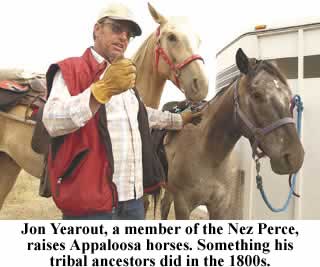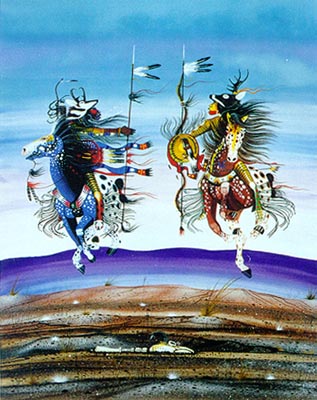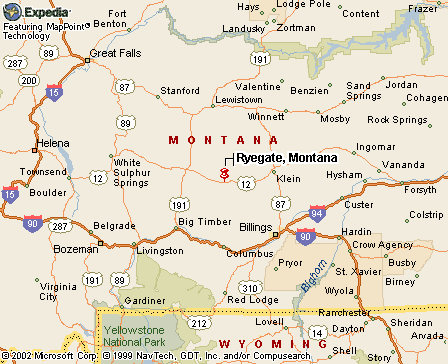|
|
Canku Ota |
|
|
(Many Paths) |
||
|
An Online Newsletter Celebrating Native America |
||
|
October 5, 2002 - Issue 71 |
||
|
|
||
|
Spirit of Spotted Horses |
||
|
by Jan Falstad Billings
Gazette Staff
|
||
|
|
 The
Appaloosa horse, tied deep into Nez Perce culture, carries modern-day
riders into the past, transcending the bitterness of war and teaching
today's young. The
Appaloosa horse, tied deep into Nez Perce culture, carries modern-day
riders into the past, transcending the bitterness of war and teaching
today's young.
Since 1965, members of the Appaloosa Horse Club have ridden the path of the 1877 retreat, 100 miles a week every summer. The journey takes them from the Wallowa Valley of Oregon to trail's end, the Bear Paw Battlefield in north-central Montana. After all the trail has been ridden, the cycle begins again. The 2002 ride started north of Ryegate, where Jon and Rosa Yearout were saddling their Appaloosa horses, kidding around as usual. The Yearouts, of the M-Y Sweetwater Appaloosa Ranch in Lapwai, Idaho, raise horses for a living. When asked how many horses he and Rosa have, Jon just grins. "We have 80 horses and they've probably had a couple of babies since we left," he laughs. "If a person knows exactly how many horses he has, he doesn't have enough." Jon points to an ancient flat-seat saddle on Prairie Dancer, an Appaloosa he and his wife own. He proudly explains that he traded a cord of wood for an 1815 saddle and points to the original date on a hand-stamped D-ring holding the cinch. Jon and Rosa value the traditional Appaloosa, a horse that was part of their tribe when Lewis and Clark passed through in 1805. Like most Nez Perce, Rosa favors a dark horse with a blanket of white spots. But the entire breed almost disappeared in a campaign to punish the Nez Perce and destroy their mobility in war. After the capture of the Nez Perce in Montana, soldiers centered the tribe's prized horse in their rifle sights. Skilled native horsemen and breeders watched as the U.S. Army shot away at their herds. Four hundred killed in one ravine. Thousands more in small bunches. The horses the Army didn't shoot were bred to heavy, slow draft horses. "They didn't want us to be mobile and fast because that was a threat," Jon Yearoutsaid. "They wanted us to have plow horses." But some horses were taken to safety in Canada. Soldiers kept some for their speed and power. Sixty years after the Nez Perce surrender, in 1937, only a few hundred remained, according to "The Appaloosa" by Bill and Dona Richardson. A couple of thousand Appaloosa horses had stayed behind at the beginning of the trek in 1877. Yearout said his ancestors never got back home to claim these animals, which lived on a rancher's land for three generations. "About 15 years ago, a rancher called and said, 'Does anyone want these horses? We've had them 100 years,' " Yearout recalled, saying he was quite surprised to learn that the original bloodlines still existed.
Henry estimates that 20 youngsters have joined the trail ride through the foundation who couldn't have gone otherwise. "Being around horses helps. A horse is somebody to be with who doesn't talk back to you,"Henry said. The Yearouts' grandson, Kellen Lewis, of Spokane, Wash., has been riding since he was little and made his second ride on the Nez Perce trail in July. For Lewis, the rhythm of a horse, the wind in his hair and a direct connection to his ancestors is captivating. "I really enjoy that," Lewis said "Nowadays, everything's so commercialized and everything, I like just going back to the old ways, riding animals and taming them." The Nez Perce trail riders welcome members of other tribes and nations. This year's trail leader was Mike Howard, a descendant of Gen. Oliver Howard, who chased theNez Perce across three states. Anyone willing to log 100 saddle miles in one week is welcome, as long as the mount is a registered Appaloosa horse. Seymour Young Dog, a Lakota Sioux from South Dakota, is a holy man. Acousin to Chief Crazy Horse, Young Dog spends part of his vacation every summer on this ride. He points out that his people helped the Nez Perce in their flight to Canada. Ten years ago, Young Dog, a pipe carrier, started holding a talking circle with drums,an eagle feather and a pipe the night before the ride beings. "The horse is another person to us. It's a ride, yes, but it's more than that," Young Dog said. "It's getting in touch with the Great Spirit. Letting him know we're not dead. We will never be." Forgiveness and healing are themes of the talking circle. "The white man caught up and they killed everything. The people, the dogs, everything.They had no respect," Young Dog said. "So, the blood of the Appaloosa was almost lost. Rosa and Jon are helping to bring them back." So mile by mile, Rosa rides with her family, passing on wisdom from long ago: People and horses pass on, but the land keeps teaching. "We honor and remember our ancestors from the war of 1877. We're not bitter, but we remain divided," Rosa Yearout said. "The horse is a way of healing."
Colored
coat of centuries
The Nez Perce got the Appaloosa horse around 1730 and within a generation were skilled riders and breeders. In their journals, Lewis and Clark praised the Appaloosas they saw among the Nez Perce and compared the Appaloosa to the best horses Virginia had to offer. Spots in the shape of a hand print were prized above all other markings. Still, no evidence exists that the Nez Perce selectively bred for the spotted color over other qualities like being sure-footed, tough and trainable. The breed name evolved from a Palouse horse named after the Palouse country in the Washington, Oregon and Idaho panhandle. That name became "A Palousy" which in turn became "Appalousie" or"Appaloosa." Source: "The Appaloosa" by Bill and Dona Richardson
|
|
|
||
|
|
||
| Canku Ota is a free Newsletter celebrating Native America, its traditions and accomplishments . We do not provide subscriber or visitor names to anyone. Some articles presented in Canku Ota may contain copyright material. We have received appropriate permissions for republishing any articles. Material appearing here is distributed without profit or monetary gain to those who have expressed an interest. This is in accordance with Title 17 U.S.C. section 107. | ||
|
Canku Ota is a copyright © 2000, 2001, 2002 of Vicki Lockard and Paul Barry. |
||
 |
 |
|
|
The "Canku Ota - A Newsletter Celebrating Native America" web site and its design is the |
||
|
Copyright © 1999, 2000, 2001, 2002 of Paul C. Barry. |
||
|
All Rights Reserved. |
||
 In
1991, the Nez Perce tribe, seeing that many children had no money or
access to horses, formed The Chief Joseph Foundation, which purchased
more than 40 registered Appaloosas. The horses are used to teach kids
Nez Perce traditions, culture and heritage and to connect them to reality
from the back of a horse. Donna Henry lives in Clarkston, Wash., and
works as a secretary at a drug and alcohol prevention program in Lapwai.
She has ridden this trail for five years and believes that the horses
help troubled youths cope with peer pressure and bad influences.
In
1991, the Nez Perce tribe, seeing that many children had no money or
access to horses, formed The Chief Joseph Foundation, which purchased
more than 40 registered Appaloosas. The horses are used to teach kids
Nez Perce traditions, culture and heritage and to connect them to reality
from the back of a horse. Donna Henry lives in Clarkston, Wash., and
works as a secretary at a drug and alcohol prevention program in Lapwai.
She has ridden this trail for five years and believes that the horses
help troubled youths cope with peer pressure and bad influences.  The
distinctive spotted coats of the Appaloosa date back to ancient China,
the Greeks and Ice Age artists in Central Europe who painted the distinctive
spotted horses on cave walls.
The
distinctive spotted coats of the Appaloosa date back to ancient China,
the Greeks and Ice Age artists in Central Europe who painted the distinctive
spotted horses on cave walls. 